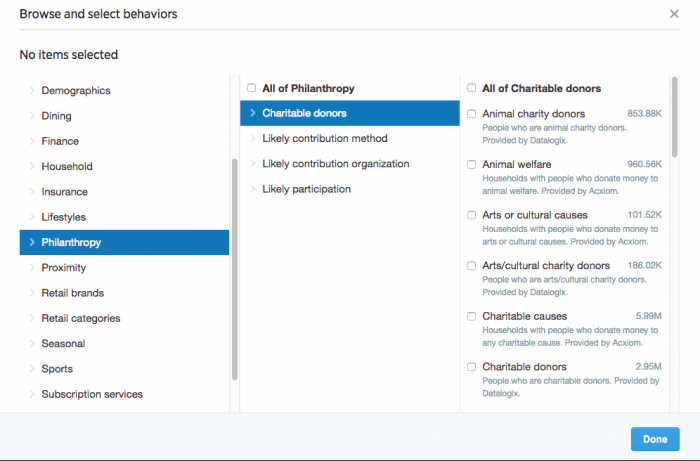Audience Building Outside of Google and Facebook
So far this week we’ve painted a darkening picture on how to build your audience with the Goofle and Facebook behemoths.. How about some good news and some good places to build your audience? A few thoughts:
Twitter. Last year, Facebook eliminated a decent amount of third-party data from ad targeting (likely because they had enough native information that the outside information was not significantly valuable). One casualty of the change was their information on who was a past charitable donor.
That information lives on in Twitter ad targeting:

Now remember this is third-party data, which is suspect as we’ve noted. But this isn’t information by which you are going to customize your pitch. Rather, it’s a limiter on your advertising audience. Thus, it’s a bit more acceptable.
There are a couple of drawbacks, however:
- Twitter’s lead generation tools aren’t of the same caliber as Facebook’s and thus usually suppress response rate. You will likely have better results paying per click, sending the person to your site, and converting them there. It’s an extra step, but a palatable one. Just make sure you mentally take the inevitable non-converters out of the equation when you calculate what you are willing to spend per click.
- Twitter just banned political ads. You may say “yay! That means they won’t have the spike in costs Facebook will experience next year!” However, we don’t know what Twitter’s definition of “political” will be. Right now, it includes “ads that advocate for legislative issues of national importance.” If that’s the standard, it will likely apply to a lot of the issues we would want to be generating leads from: climate change, gun rights/control, civil liberties, reproductive rights, etc. etc. Since petitions and issue advocacy are a tried and true way of getting people to sign on the line that is dotted with their contact information, we may be losing a significant part of what we would advertise about. Rules come out November 15, so keep an eye out, as my “political” may be your “common sense” or “factual.” And vice versa.
Face-to-face/DRTV. I dip my toe into these waters cautiously, as a previous Agitator F2F forays into the subject turned into a real donnybrook, ballyhoo, fracas, and other old-timey words for fight. In the end, I think we all agreed that F2F done well – that is, with an eye toward retention – was good and F2F done poorly – without an eye toward retention – was bad. Beyond that I shall not go for now.
But what is interesting is that those who are doing face-to-face of all stripes and DRTV (to a slightly lesser extent) are finding that the donors they are getting are not only new to file, but also folks they haven’t been reaching through other channels. This makes sense – if you want a fresh apple, you get it from the tree, not the barrel.
But the whole goal of audience building is to bring new people into philanthropy. It seems to be succeeding in those channels that don’t screen for whether someone has donated before while others are trying to get people who give generally to add another organization to their giving list.
(And yes, I just advocated on behalf of Twitter’s donation filter. Feel free to remove that if your goal is to bring new people into giving.)
Other content techniques. We talked a little about how creating good content is a salve to worrying about search engine optimization. But did you know there are content strategies that (gasp) aren’t digital?
Maybe it’s because I just finished Bill Shore’s The Cathedral Within about the growth of Share Our Strength and am on to Scott Harrison’s Thirst about Charity: Water’s work. Or maybe it’s because Roger and I have both used books as content marketing strategies (in addition to Retention Fundraising and The New Nonprofit both being darn good reads).
But it seems like there’s untapped potential to take your blog posts, bundle them, and tell the story of your organization in book form. Or partner with that documentary filmmaker. Or create coursework/class materials so your topic can be effectively taught in schools. There’s myriad ways to get your message into the world; we’ve just done the easy ones first.
Nick



You are right! As usual because you have done good research. My organization Nyaka has benefited from two books I have written A school for my village and Victory for my village.
The two films Cornerstone and now Victors! More to come and one day hope you read one of those books.